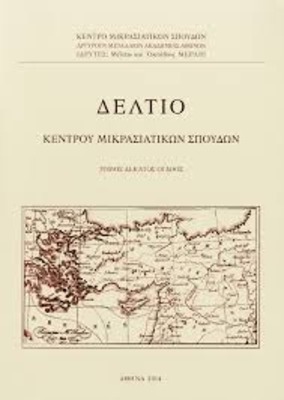Φωκαϊκά σπαράγματα
Part of : Δελτίο Κέντρου Μικρασιατικών Σπουδών ; Vol.15, 2008, pages 39-162
Issue:
Pages:
39-162
Parallel Title:
Phocean miscellanies
Section Title:
Articles
Abstract:
The starting point for this publication of miscellaneous materials regardingPhocaea was the discovery of the dossier of the French archaeologist FélixSartiaux that had been deposited in the French Archeological School in Athens but was so far considered lost. Sartiaux excavated in the area ofPhocaea (Western Asia Minor) during the troubled years 1913-1921, a workwhich, owing to the sad events of the summer of 1922, had to stop and beresumed after the 1950s by the Turkish archaeologists Akurgal and Ozyigit.Sartiaux was primarily interested in the archaic period of the town whichwas closely associated with the Greek colonisation of the Western Mediterranean,especially the foundation of Marseille. Yet his letters and archeologicalreport published here provide valuable information for later periods of thetown as well, among which the Genoese and modern periods. Furthermore,they document the wider interest of French archeologists in claiming thedomain of Western Asia Minor for themselves and away from their Germancounterparts.The publication of Sartiaux’s dossier is supplemented here with specificstudies on the medieval history and archeology of the town. StephanosEfthymiadis discusses all scattered evidence concerning Byzantine Phocaea,when the town, a rather small bishopric, was mostly known as a centre ofproduction of ceramics, textiles, and probably alum, a mineral that was latercommercially exploited by the Genoese (end of 13th c.- 15th c.). Its mentionin the edict of Alexios I Komnenos that granted privileges to the Venetians(1082) and the attestation of an Amalfitan merchant as its inhabitant in the12th century show that Phocaea began to acquire a certain economicsignificance well before its concession by Michael Vili Paleologos to theGenoese family of Zaccaria (ca. 1268). The study of Andreas Mazarakis,“The Zaccaria in Phocaea (ca. 1268-1329),” is concerned with problems ofprosopography and the trading activity of this family. Drawing onhistoriography, numismatics, and Genoese notarial documents, the authordiscards previous misunderstandings and puts in order all the informationregarding the political and other activities of the Zaccaria in the Byzantineor Frankish Levant. His four other studies concern the problems of alumexploitation in Old Phocaea and on the adjacent island of Lesbos; thecommemorative slab of the Gattelusi, lords of Mytilene and Old Phocaea,walled in a still standing nineteenth-century house; the anonymous Venetianatlas MGI 1694 of the National Library of Austria, which dates from theyear 1656 and features a representation of Old Phocaea; and a note on theproperty status of land-owners in Phocaea as recorded in the map drawn upby Sartiaux in 1921.
Subject:
Subject (LC):




